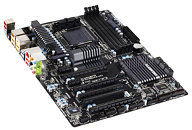Wednesday, September 21st 2011

Gigabyte Unveils 990FXA-UD3 1.2 Motherboard
Gigabyte unveiled a new socket AM3+ motherboard targeting a price-point sweetspot, the 990FXA-UD3 1.2. The board is based on the AMD 990FX + SB950 chipset, and supports the upcoming AMD FX processors apart from socket AM3 processors in the Phenom II and Athlon II series. As a new revision, the board supports AMD FX processors out of the box. The AM3+ socket is powered by an 8+2 phase VRM. The board is constructed according to the UltraDurable 3 Classic specifications, with 2 oz copper-layer PCB, 50,000+ hours capacitor durability, and DualBIOS. The socket is wired to four DDR3 DIMM slots supporting dual-channel DDR3-2000 MHz memory with overclocking.
There are four PCI-Express x16 slots on this board, however, only two of them are wired to the AMD 990FX northbridge, both run at full PCI-Express 2.0 x16 bandwidth at all times. The other two are electrical PCI-Express x4, wired to the SB950 southbridge. The board supports both NVIDIA SLI and AMD CrossFireX, though it's likely that it will ship with just the 2-way SLI bridge cable.Other expansion slots include two PCI-Express x1, and one legacy PCI. All six SATA 6 Gb/s ports from the southbridge are assigned as internal ports, there are two eSATA 3 Gb/s ports, driven by a JMicron JMB363 controller. There are four USB 3.0 ports, two on the rear panel, two via a standard header, driven by Etron EJ168 controllers. Other connectivity includes 8 channel HD audio driven by Realtek ALC889 codec, one gigabit Ethernet connection by Realtek RTL8111E, and FireWire. The board makes use of traditional AwardBIOS, with HybridEFI extensions that lets you boot from volumes bigger than 2.2 terabytes.
The GA-990FXA-UD3 1.2 will be priced at about US $160.
There are four PCI-Express x16 slots on this board, however, only two of them are wired to the AMD 990FX northbridge, both run at full PCI-Express 2.0 x16 bandwidth at all times. The other two are electrical PCI-Express x4, wired to the SB950 southbridge. The board supports both NVIDIA SLI and AMD CrossFireX, though it's likely that it will ship with just the 2-way SLI bridge cable.Other expansion slots include two PCI-Express x1, and one legacy PCI. All six SATA 6 Gb/s ports from the southbridge are assigned as internal ports, there are two eSATA 3 Gb/s ports, driven by a JMicron JMB363 controller. There are four USB 3.0 ports, two on the rear panel, two via a standard header, driven by Etron EJ168 controllers. Other connectivity includes 8 channel HD audio driven by Realtek ALC889 codec, one gigabit Ethernet connection by Realtek RTL8111E, and FireWire. The board makes use of traditional AwardBIOS, with HybridEFI extensions that lets you boot from volumes bigger than 2.2 terabytes.
The GA-990FXA-UD3 1.2 will be priced at about US $160.

38 Comments on Gigabyte Unveils 990FXA-UD3 1.2 Motherboard
I wonder if it was because they ran out of Marvell 88SE9172 chips and couldn't get a good deal on another batch, or if they're just cutting costs and upping their margins, or because the UD5 has the Marvell chips and they were seeing more UD3s selling than they expected.
I'm guessing the latter two reasons combined.
Anyway, it's likely that this board and its compatriots will not be in production when Windows 8 is released next year. So, unless you're planning on upgrading for no good reason, this board and Windows 7 is likely to have a long life -- consider all the hundreds of millions of users around the world who still use Windows XP...
im not going to buy from the ONE brand out there that doesn't allow me that option when every other board is just as good but DOES give me UEFI
Also, the preview release of Windows 8, just released is a year of development from final release. Microsoft wants to hear feedback from developers so that they can tweak, tune, and modify what they've got so far.
To a power user, the current iteration of Windows 8 is not ideal. So, if that does not change, then (just as when Vista was released), you'll see many people staying with the previous windows version, in this case Windows 7 (in the Vista case, Windows XP).
It's wayyyy too soon to be talking final release features anyway...
redmondmag.com/articles/2011/09/23/windows-8-dual-boot-possible-if-secure-boot-disabled.aspx
and,
"Early adopters can run Windows 8 Developer Preview even on modest, pre-Vista era hardware, and I don’t expect this to change for the RTM Build of the operating system. "
news.softpedia.com/news/Windows-8-Developer-Preview-System-Requirements-222306.shtml
So, the whole thing is a moot point; there is no problem with running Windows 8 on a Mobo with traditional BIOS instead of UEFI.
The 'net may be a 'frathouse for retards' but it does have its moments :)
Back on topic, just got myself one of them mobos, installing it later today. :)
Meh.
I think I'll stick with ASUS.
Although I haven't overclocked my cpu too much; no voltage added.
The only weird thing I've come across is the apparent AMD guidelines for the chipset saying that VDroop is to be expected when overclocking. Apparently, it's OK to run with a high voltage at idle, because the chipset will automatically reduce the voltage when running under load, to a safer and more manageable level for the overclock (aka VDroop). It feels like a loss of control, letting the chipset do its thing to stabilize the overclock.
I can see why many people who initially bought 990fx boards complained about VDroop. AMD changed the overclocking 'rules'.